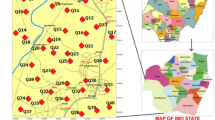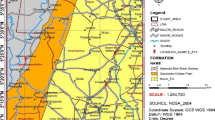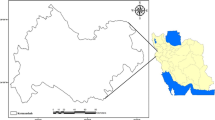Abstract
This study integrated machine learning and multi-linear regression modeling approaches in groundwater quality assessment around Obosi, SE Nigeria with the aim of predicting groundwater quality parameters. 42 groundwater samples were collected and analyzed for physical (Ec and pH) and heavy metals (As, Fe, Ni, Cu, Cr, Pb) using standard methods. The result of physicochemical assessment revealed that Ec, pH, Cr, and Ni were within the recommended standard whereas Cd, Fe, Pb, and As were above with a heavy metal trend spread of Fe > Pb > As > Cd > Cr > Ni. The study area’s aquiferous materials are highly permeable and relatively shallow, hence the observed groundwater contamination. Contamination factor results showed that the entire samples were not contaminated, except which had majority of its samples having very high degree of contamination. Pollution load index (PLI) values revealed excellent groundwater quality. The Heavy Metal Evaluation Index (HEI), Potential ecological risk index (ERI) and modified degree of contamination (mCd) values reveal that majority of the entire groundwater sample has high contamination. Elemental Contamination Index and overall Metal Contamination Index (MCI) values in the entire sample were less than 5 which implies that they have very low contamination. Water quality index (WQI) and Pollution index of groundwater (PIG) values showed that the water quality is unsuitable for drinking and it requires treatment before usage. Correlation matrix result showed no correlation between the parameters. Principal component analysis results showed that there were loading between parameters. Eight (8) Artificial neural networks (ANN) and multi-linear regression (MLR) models were developed with very high R2 values, showing that they are efficacious and reliable for the forecasting of the pollution indices. Based on the respective performances, ANN and MLR models should be considered for additional investigation since they showed a high viable inclination in the forecasting of PLI, Igeo, HEI, mCd, ERI, MCI, WQI and PIG.










Similar content being viewed by others
Data availability
The datasets generated during and/or analyzed during the current study are available from the corresponding author on reasonable request.
References
Abba, S. I., Hadi, S. J., Sammen, S. S., Salih, S. Q., Abdulkadir, R. A., Pham, Q. B., & Yaseen, Z. M. (2020). Evolutionary computational intelligence algorithm coupled with self-tuning predictive model for water quality index determination. Journal of Hydrology, 587, 124974.
Abrahim, G. M. S., & Parker, R. J. (2008). Assessment of HMenrichment factors and the degree of contamination in marine sediments from Tamaki Estuary, Auckland, New Zealand. Environmental Monitoring Assessment, 136, 227–238.
Adnan, R. M., Khosravinia, P., Karimi, B., & Kisi, O. (2021). Prediction of hydraulics performance in drain envelopes using Kmeans based multivariate adaptive regression spline. Applied Soft Computing, 100, 107008. https://doi.org/10.1016/j.asoc.2020.107008
Agidi, B. M., Akakuru, O. C., Aigbadon, G. O., Schoeneich, K., Isreal, H., Ofoh, I., Njoku, J., & Esomonu, I. (2022). Water quality index, hydrogeochemical facies and pollution index of groundwater around Middle Benue Trough, Nigeria. International Journal of Energy and Water Resources. https://doi.org/10.1007/s42108-022-00187-z
Ahmed, U., Mumtaz, R., Anwar, H., Shah, A. A., Irfan, R., & García-Nieto, J. (2019). Efficient water quality prediction using supervised Machine Learning. Water, 11(11), 2210. https://doi.org/10.3390/w11112210
Aikpokpodion, P. E., Lajide, L., & Aiyesanmi, A. F. (2010). Heavy metals contamination in fungicide treated cocoa plantations in cross river state, Nigeria American-Eurasian American-Eurasian. Journal of Agriculture and Environental Science, 8(3), 268–274.
Akakuru, O. C., & Akudinobi, B. E. B. (2018). Qualitative characterization of groundwater sources around nigeria national petroleum corporation oil depot aba, using multiple linear regressions modelling. International Journal of Advanced Geosciences, 6(1), 57–64.
Akakuru, O. C., Akudinobi, B. E., Nwankwoala, H. O., Akakuru, O. U., & Onyekuru, S. O. (2021b). Compendious evaluation of groundwater in parts of Asaba, Nigeria for agricultural sustainability. Geosciences Journal. https://doi.org/10.1007/s12303-021-0010-x
Akakuru, O., Akudinobi, B., Okoroafor, P., & Maduka, E. (2017). Application of geographic information system in the hydrochemical evaluation ofgroundwater in parts of Eastern Niger Delta Nigeria. American Journal of Environmental Policy and Management, 3(6), 39–45.
Akakuru, O. C., Akudinobi, B., Opara, A. I., Onyekuru, S. O., & Akakuru, O. U. (2021a). Hydrogeochemicalfacies and pollution status of groundwater resources of Owerri and environs Southeastern Nigeria. Environmental Monitoring and AssessMent, 193, 623. https://doi.org/10.1007/s10661-021-09364-9
Akakuru, O. C., Eze, C. U., Okeke, O. C., Opara, A. I., Usman, A. O., Iheme, O. K., Ibeneme, S. I., & Iwuoha, P. O. (2022). Hydrogeochemical evolution, water quality indices, irrigation suitability and pollution index of groundwater (PIG) around Eastern Niger Delta. Nigeria. International Journal of Energy and Water Resources. https://doi.org/10.1007/s42108-021-00162-0
Arinze, I. E., Igwe, O., & Una, C. O. (2015). Analysis of heavy metals’ contamination in soils and water at automobile junk markets in Obosi and Nnewi, Anambra State Southeastern Nigeria. Arab Journal of Geoscience. https://doi.org/10.1007/s12517-015-2001-6
Awachie, J. B., & Ezenwaji, H. (1981). The fisheries development of the Anambra River Basin, Nigeria. CIFA Tech Pap, 8, 212–224.
Bagheri, M., Bazvand, A., & Ehteshami, M. (2017). Application of artifcial intelligence for the management of landfll leachate penetration into groundwater, and assessment of its environmental impacts. Journal of Cleaner Production, 149, 784–796. https://doi.org/10.1016/j.jclepro.2017.02.157
Caeiro, S., Costa, M. H., Ramos, T. B., Fernandes, F., Silveira, N., Coimbra, A., Medeiros, G., & Painho, M. (2015). Assessing HMcontamination in Sado estuary sediment: An index nnuivsis approach. Ecological Indicators, 5, 151–169.
Deng, T., Chau, K. W., & Duan, H. F. (2021). Machine learning based marine water quality prediction for coastal hydro-environment management. Journal of Environmental Management, 284, 112051.
Eyankware, M. O., & Akakuru, O. C. (2022). Appraisal of groundwater to risk contamination near an abandoned limestone quarry pit in Nkalagu, Nigeria, using enrichment factor and statistical approaches. International Journal of Energy and Water Resources. https://doi.org/10.1007/s42108-022-00186-0
Eyankware, M. O., Akakuru, O. C., & Eyankware, E. O. (2022c). Interpretation of hydrochemical data using various geochemical models: a case study of Enyigba mining district of Abakaliki, Ebonyi State, SE Nigeria. Sustainable Water Resources Management. https://doi.org/10.1007/s40899-022-00613-4
Eyankware, M. O., Akakuru, O. C., Ulakpa, R. O. E., & Eyankware, E. O. (2022a). Hydrogeochemical approach in the assessment of coastal aquifer for domestic, industrial, and agricultural utilities in Port Harcourt urban, Southern Nigeria. International Journal of Energy and Water Resources. https://doi.org/10.1007/s42108-022-00184-2
Eyankware, M. O., Akakuru, O. C., Ulakpa, R. O. E., & Eyankware, O. E. (2021). Sustainable management and characterization of groundwater resource in coastal aquifer of Niger delta basin Nigeria. Sustainable Water Resources Management, 7, 58. https://doi.org/10.1007/s40899-021-00537-5
Eyankware, M. O., Eyankware, R. O., & Akakuru, O. C. (2022b). Hydrogeophysical delineation of aquifer vulnerability in parts of Nkalagu and OhofiaAgba areas of Abakaliki SE. Nigeria. Sustainable Water Resources Management. https://doi.org/10.1007/s40899-022-00603-6
Ghorbani, M., Aalami, M., Naghipour, L. Use of artificial neural networks for electrical conductivity modelling
Guzman, J., Shirmohammadi, A., Wang, X., Chu, M. L., Jha, M., & Hernandez, J. E. (2015). Uncertainty considerations in calibration and validation of hydrologic and water quality models. Transactions of the ASABE, 58(6), 1745–1762. https://doi.org/10.13031/trans.58.10710
Hakanson, L. (1980). An ecological risk index for aquatic pollution control. A Sedimentological Approach Water Res, 14, 975–1001.
Hasda, R., Rahaman, M. F., Jahan, C. S., Molla, K. I., & Mazumder, Q. H. (2020). Climatic data analysis for groundwater level simulation in drought-prone Barind Tract, Bangladesh: Modelling approach using artificial neural network. Groundwater for Sustainable Development, 10, 100361.
Iloeje, N. P. (1965). A new geography of Nigeria. Longmans of Nigeria, Ikeja in Asi River. Applied Water Science, 2017(7), 1761–1772.
Kumar, S., Kumar, M., Chandola, V. K., Kumar, V., Saini, R. K., Pant, N., & Chaudhary, A. (2021). Groundwater quality issues and challenges for drinking and irrigation uses in central ganga basin dominated with rice-wheat crop** system. Water, 13(17), 2344.
Loaiza, J. G., Bustos-Terrones, Y., Bustos-Terrones, V., Monjardín-Armenta, S. A., Quevedo-Castro, A., Estrada-Vazquez, R., & Rangel-Peraza, J. G. (2022). Evaluation of the hydrochemical and water quality characteristics of an aquifer located in an urbanized area. Applied Sciences, 12(14), 6879.
Mattas, C., Anagnostopoulou, C., Venetsanou, P., Bilas, G., Lazoglou, G. (2019). Evaluation of Extreme Dry and Wet Conditions Using Climate and Hydrological Indices in the Upper Part of the Gallikos River Basin. Proceedings
Musa, Y. S., Abubakar, F., & Abdu, N. (2021). Ecological risk assessment of heavy metal contaminated soils of selected villages in Zamfara State Nigeria SN. Applied Sciences, 3, 168. https://doi.org/10.1007/s42452-021-04175-6
Nathan, N. S., Saravanane, R., & Sundararajan, T. (2017). Application of ANN and MLR Models on Groundwater Quality Using CWQI at Lawspet, Puducherry in India. Journal of Geoscience and Environment Protection, 5, 99–124.
Nfor, B. N., Olobaniyi, S. B., & Ogala, J. E. (2007). Extent and distribution of groundwater resources in parts of Anambra State, Southeastern Nigeria. Journal of Applied Sciences and Environmental Management, 11(2), 215–221.
Obasi, P. N., Akakuru, O. C., Nweke, O. M., & Okolo, C. M. (2022). Groundwater assessment and contaminant migration in fractured shale aquifers of Abakaliki mining areas, Southeast Nigeria. Journal of Mining and Geology., 58(1), 211–227.
Opara, A. I., Akaolisa, C. C. Z., Akakuru, O. C., Nkwoada, A. U., Ibe, F. C., Verla, A. W., & Chukwuemeka, I. C. (2021). Particulate matter exposure and non-cancerous inhalation health risk assessment of major dumpsites of Owerri metropolis, Nigeria. Environmental Analysis Health Toxicology. https://doi.org/10.5620/eaht.2021025
Prasanna, M. V., Praveena, S. M., Chidambaram, S., Nagarajan, R., & Elayaraja, A. (2012). Evaluation of water quality pollution indices for heavy metal contamination monitoring: A case study from Curtin Lake, Miri City East Malaysia. Environment Earth Science, 2012(67), 1987–2001. https://doi.org/10.1007/s12665-012-1639-6
Qureshi, S. S., Channa, A., Memon, S. A., Khan, Q., Jamali, G. A., Panhwar, A., & Saleh, T. A. (2021). Assessment of physicochemical characteristics in groundwater quality parameter. Environmental Technology & Innovation. https://doi.org/10.1016/j.eti.2021.101877
Reyment, R. A. (1965). Aspects of the geology of Nigeria (p. 133). University of Ibadan, Nigeria Press.
Singh, V. K., Singh, K. P., & Mohan, D. (2005). Status of heavy metals in water and bed sediments of River Gomti—A tributary of the Ganga River, India. Environmental Monitoring Assessment, 105, 43–67.
Subba Rao, N., Sunitha, B., Rambabu, R., Nageswara Rao, P. V., Surya Rao, P., Spandana, B. D., Sravanthi, M., & Marghade, D. (2018). Quality and degree of pollution of groundwater, using PIG from a rural part of Telangana State India. Applied Water Science, 8, 227. https://doi.org/10.1007/s13201-018-3950864-x
Touaylia, S., Ghannem, S., Toumi, H., Bejaoui, M., & Garrido, J. (2016). Assessment of heavy metals status in northern Tunisia using contamination indices: Case of the Ichkeul steams system. International Research Journal of Public and Environmental Health, 3(9), 209–217.
Urom, O. O., Opara, A. I., Usen, O. S., et al. (2021). Electro-geohydraulic estimation of shallow aquifers of Owerri and environs, Southeastern Nigeria using multiple empirical resistivity equations. International Journal of Energy and Water Resources. https://doi.org/10.1007/s42108-021-00122-8
Usman, A. O., Iheme, K. O., Chinwuko, A. I., Azuoko, G., & Akakuru, O. C. (2022). Hydro-geophysical investigation of groundwater resources within Abakaliki, Lower Benue Trough Nigeria. COOU Journal of Physical Sciences, 5(1), 473–491.
World Health Organization (WHO) (2017). Guidelines for drinking water quality, 4th (edn) NLM classification: WA 675, World Health Organization, Geneva, Switzerland, pp 307–433
Zafar, M. M., Sulaiman, M. A., Prabhakar, R., & Kumari, A. (2022). Evaluation of the suitability of groundwater for irrigational purposes using irrigation water quality indices and geographical information systems (GIS) at Patna (Bihar), India. International Journal of Energy and Water Resources. https://doi.org/10.1007/s42108-022-00193-1
Author information
Authors and Affiliations
Corresponding author
Ethics declarations
Conflict of interest
The authors declare that they have no competing interests.
Ethical approval
As per the literature review, this is neither a repetition of any work nor copied key data from other’s work. The methodology, findings, and conclusions made here belong to original research work as per our knowledge and belief.
Human and animal rights
This research work is carried out in compliance with transparency, moral values, honesty, and hard work. No human participation or animals are involved in this research work.
Informed consent
Every step of processing for publication informed to all co-authors of this paper at the earliest, and everything is carried out with collective decision and consent.
Additional information
Publisher's Note
Springer Nature remains neutral with regard to jurisdictional claims in published maps and institutional affiliations.
Rights and permissions
Springer Nature or its licensor holds exclusive rights to this article under a publishing agreement with the author(s) or other rightsholder(s); author self-archiving of the accepted manuscript version of this article is solely governed by the terms of such publishing agreement and applicable law.
About this article
Cite this article
Akakuru, O.C., Akaolisa, C.C.Z., Aigbadon, G.O. et al. Integrating machine learning and multi-linear regression modeling approaches in groundwater quality assessment around Obosi, SE Nigeria. Environ Dev Sustain 25, 14567–14606 (2023). https://doi.org/10.1007/s10668-022-02679-8
Received:
Accepted:
Published:
Issue Date:
DOI: https://doi.org/10.1007/s10668-022-02679-8




